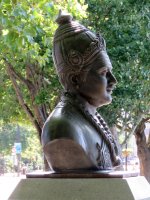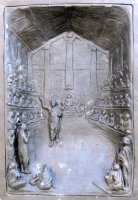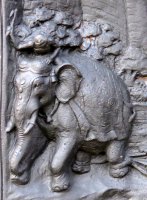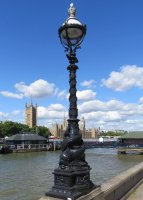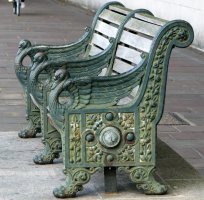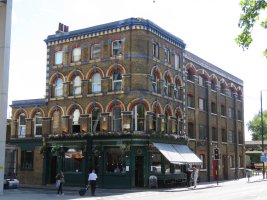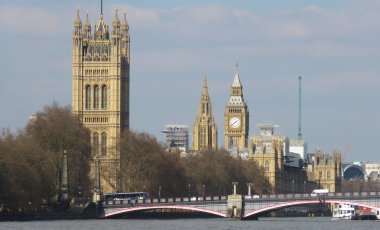Albert Embankment Gardens sculpture
Albert Embankment Gardens, a scrap of green space on the south side of the Thames near Lambeth Palace, has a couple of pieces of modern statuary, Victorian street furniture, and views.
Along the south bank of the Thames, walking between Lambeth Bridge and Vauxhall Bridge, the visitor is first walking next to the traffic, albeit with fine views of the river, and then on a newly reopened pathway with modern buildings separating the pedestrian from the road. At this point where we take the path, is the small sliver of green space, called Albert Embankment Gardens, with a couple of bits of sculpture.
Sridhara Murthy's bust of Basaveshwara.
In the centre of this space is a modern bust of a 12th Century Indian philosopher who apparently espoused equality and a move away from the caste system, called Basaveshwara. The piece was commissioned in 2011 by the Mayor of Lambeth at the time, and a local foundation he set up, and the government of Karnataka, India, to highlight his work promoting a similar democratic ideal to that of British democracy; it was unveiled rather later, in 2015. While the subject has no obvious links to Lambeth, additional representational statues in London are generally to be welcomed, and it is an interesting example of modern Indian sculpture in the capital. The bust is highly finished, in a bland, symmetrical composition staring straight ahead, with ceremonial headpiece and necklaces, over an unobtrusive light garment. On the sides of the base are a pair of relief panels, one showing presumably Basaveshwara declaiming to hall full of mostly seated figures, and the other an elephant going past the walls of some castle, a building with cavalry behind, writhing figures in the foreground. The elephant is commendable. The whole piece was made by sculptor Sridhara Murthy. Other elephant sculpture, including another Indian one, on this page.
David Harber's 'Titan', celestial navigation.
Off to one side, close by the tall building looming over the green patch, is a small statue of an Atlas-type figure, with a wire-fram globe on his back, known as an armillary sphere. It was erected in about 2011, so at the same time the Basaveshwara bust, by the International Maritime Organisation, whose headquarters - with a massive bronze prow of a ship in front - are just down the road. So we have Atlas, representing here strength or endurance, and the armillary sphere, symbolic of celestial navigation. The title of the work is actually Titan, and the sculptor is David Harber, whose work often features spheres.
Along with these two bronze pieces, we have cast iron street furniture contemporary with the creation of the Embankment. Firstly, the characteristic dolphin lamp posts, found on both sides of the water, some dating from 1870, thus immediately following the completion of the Albert Embankment in 1869, the master work of the engineer Joseph Bazelgatte, supported on this side by another engineer, John Grant. The dolphins are sometimes referred to as sturgeon, and indeed their physiology is closer to the sturgeon than the dolphin, and yet these are similar to the Classical dolphins of Roman times, reproduced so often in Renaissance Italy and later.
One of Vulliamy's Swan benches.
The significant architect G.J. Vulliamy was the designer, and the pieces were modelled by Charles Henry Driver. Vulliamy was also responsible for the swan and camel benches along the Embankment, with three benches here with the swan design; curiously, these benches still rest on lion's feet. His most well known works are the massive sphinxes at the base of Cleopatra's Needle on the north side (Victoria Embankment) a bit further downriver. Swan sculpture is not so widespread in England; some other examples are on this page.
High Victorian Renaissance style.
Facing inland, thus south, we can see a surviving Victorian warehouse, in yellow London brick with nice arched windows with red brick, a bit of white terra cotta, and painted edgings for a bit of polychromy. Once there were many such, and there are still some to be found dotted around the south bank area. Looking downriver, we see the five low arches of Lambeth Bridge, built by the engineer George Humphreys, with Reginald Blomfield and George Topham Forrest as consultant architects. Behined this, the Houses of Parliament with the Victoria Tower most prominent from this view.
Lambeth Bridge and Houses of Parliament.
Almost directly across the river is Tate Britain, the original Tate Gallery. While the late Victorian Classical building itself, built in 1897 to the design of architect Sidney Smith, is rather obscured by trees except in the winter months, always visible is the figure on top of the pediment looking towards us - she carries a trident and the Union Jack decorates her shield, for she is Britannia, a most appropriate symbol for the national gallery of British art. (More statues of Britannia on this page.)
There are other sculpural things nearby on this south side of the River, notably the statues on Vauxhall Bridge, and the old Doulton ceramic factory on Black Prince Road - although their forte was ceramic, this firm also cast the Swan benches along the Embankment.
